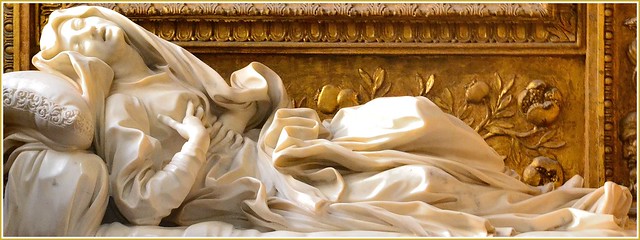Apollo and Daphne
Gian Lorenzo Bernini
 It was a
sculture made by the Italian Gian
Lorenzo Bernini between 1622 and 1625, this artistic work is displayed in Rome, in the Gallería Borghese, to be specific.
It was a
sculture made by the Italian Gian
Lorenzo Bernini between 1622 and 1625, this artistic work is displayed in Rome, in the Gallería Borghese, to be specific.
Bernini
was born in Nápoles, on the 7th of December, in 1598, and he died in
Rome, on the 24th of November, in 1680.
He
was a fantastic sculptor, painter and architect in the Barroque period who stood because he could capture the dramatic feelings and the motion really
well, as we can see in the Apollo and Daphne sculpture
 The
work speak about the myth that it’s in the name of the sculpture, Apollo and
Daphne, that is part of the Greek mythology, always in art, the most important part
that you have to look for is the story that there are behind the work.
The
work speak about the myth that it’s in the name of the sculpture, Apollo and
Daphne, that is part of the Greek mythology, always in art, the most important part
that you have to look for is the story that there are behind the work.
A greek love
The
myth starts when Apollo challenged to Eros with the bow. Eros feel cross, so he threw a golden arrow to Apollo, that caused an instant fall in love, and the
woman that he wanted was Daphne, who was injured by
the lead arrow, that caused the opposite effect.
One day, Apollo saw
Daphne and pursued her,
and she escaped as
fast as possible until she arrived to her father, the Peneus river, who
transformed her into a
laurel.
Apollo, when he saw her, hung the woman that was transforming, cried, and said: ‘’You can’t be my woman, you will be my favorite tree, your leaves will always be green and will crown all the people’s heads as victory symbol.’’
Apollo, when he saw her, hung the woman that was transforming, cried, and said: ‘’You can’t be my woman, you will be my favorite tree, your leaves will always be green and will crown all the people’s heads as victory symbol.’’
If
you round the Bernini’s work, you can find the back of Daphne transforming into a three, just where Apollo is touching her, and in the front,
Dafne has the form of a woman, this image capture the feeling of anxiety of Apollo when he saw his love transform into a three, but he continued to be in love
Photo sources
Bernini photo:http://www.biografiasyvidas.com/biografia/b/bernini.htm
Apollo and Daphne photos:http://en.wikipedia.org/wiki/Apollo_and_Daphne_(Bernini)#mediaviewer/File:ApolloAndDaphne.JPG,https://blogger.googleusercontent.com/img/b/R29vZ2xl/AVvXsEg5WzNT5dIo3YXyTXoqizVi3v_4C08MxxWpHguYNuGIY0Qz83m34m_yB2UjrkALbyTdhaUfXuKS-MZGmb2hbNCwDcHKz1U8ujg31Ik3jn-zwygRf1DgCj4EvCzH2vpuJMU7iNIHU_LL5HeB/s1600/bernini_apollo_and_daphne.jpg and http://domuspucelae.blogspot.com.es/2012/02/visita-virtual-apolo-y-dafne-el-mito.html
Information sources
Bernini information: http://domuspucelae.blogspot.com.es/2012/02/visita-virtual-apolo-y-dafne-el-mito.html and http://www.biografiasyvidas.com/biografia/b/bernini.htm
Apollo and Daphne information: http://domuspucelae.blogspot.com.es/2012/02/visita-virtual-apolo-y-dafne-el-mito.html and http://mitosyleyendascr.com/mitologia-griega/grecia58/
Fco.Javier Martín-Pueblas Pérez-bustos 4ºB ''Apollo and Daphne''












.jpg)
